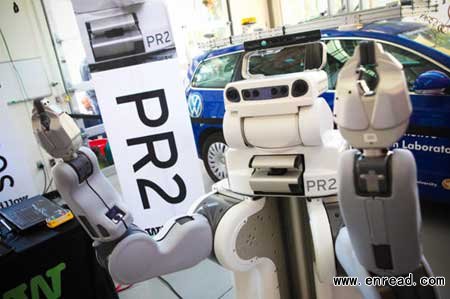| ||||||||||||||||||||||||||||||||||||||||
|
When I walked onto the Stanford University campus this week and into the Volkswagen Automotive Innovation Lab, I was greeted by a short, gray robot waving his two long arms -- he was looking for a high-five.
这个星期,我来到了美国斯坦福大学校园,当我走进大众汽车创新实验室时,一个灰色的身材矮小的机器人挥舞着两条长长的手臂欢迎我的到来,并想与我击掌。
 Silicon1 Valley Robot Block Party on Wednesday, hosting some of the best in research, industrial, and homemade robotics." style="cursor:pointer" onclick="window.open('/upimg/allimg/130419/1_130419083857_1.jpg')" /> Silicon1 Valley Robot Block Party on Wednesday, hosting some of the best in research, industrial, and homemade robotics." style="cursor:pointer" onclick="window.open('/upimg/allimg/130419/1_130419083857_1.jpg')" />In celebration of National Robotics Week, Stanford hosted the Silicon Valley Robot Block Party on Wednesday, hosting some of the best in research, industrial, and homemade robotics. All around me robots of all sizes were roaming the floor. I was trapped -- in the future.
Billed as the Silicon Valley Robot Block Party and held during National Robotics Week, the party yesterday was a celebration of human-robot interactions. Developers, researchers, and makers2 shared tips and explored the very ideas of what a robot can be and do. The people I met here are interested in robots on many levels. There were startups pitching their businesses, home-brew builders looking to have some fun, high-school kids building competition robots, and Ph.D. students just exploring.
That high-fiving robot? It's the creation of Willow3 Garage, a founding member of the Silicon Valley Robotics group that hosted the block party. In 2010, Willow Garage announced it would be delivering 11 of its $400,000 PR-2 robots free to research groups. The program, however, which began as an open-source platform intended to encouraged roboticists to collaborate4 on creating a universal robot language, has quickly evolved. After just a few years, following an announcement in February, Willow Garage says it is shifting toward becoming a profitable and self-sustaining company. What's next in the lives of robots? That's the question everyone here wants to answer.
Even after the PR-2's 2010 release, within a year the stereoscopic cameras that provided the PR-2's vision were replaced with commercially available hardware -- Microsoft's Kinect, highlighting the rigorous pace of innovation. The commercial, off-the-shelf technology available to each of us today, as NASA has discovered, is fast, smart, and constantly upgraded.
And as the evolution of robotics quickens, maybe that's what events like National Robotics Week and the Robot Block Party, are all about. There's a sense that though robots are already a great part of our lives, we are still in the early stages of robotics innovation. Things are evolving quickly. For that reason, a marketplace of ideas such as this is incredibly important.
People and ideas are being connected. Across genres5, robotics hobbyists are talking to startups, educators are talking with industry, and students are talking to engineers -- all with a focus on the future -- envisioning a future where automation is smarter, machines are more useful, and everyone has the technical skills to live side by side with our robot friends.
点击  收听单词发音 收听单词发音
|
||||||||||||||||||||||||||||||||||||||||
TAG标签:
university
innovation
robots
- 发表评论
-
- 最新评论 进入详细评论页>>



